Toyota Prius
Front Brake Pads Replacement Guide
How to replace the front disc brake pads
on a third generation 2010 to 2015 Toyota Prius hybrid with pictures.
By Paul B. Michaels Author & Photographer Auto Mechanic Since 1989 |
||
| Please note, I am not a professional automotive mechanic. I assume no liability for any damages to your vehicle, property, persons or pets. If you have any doubts, please consult your Toyota dealership or an ASE certified automotive technician. | ||
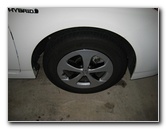 2012 Prius Front Wheel |
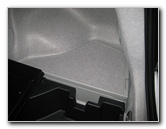 Open Tailgate - Passenger Side |
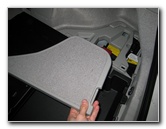 Remove 12V Battery Cover |
|
This automotive "how-to" guide was specifically written to assist owners of the third generation (2010, 2011, 2012, 2013, 2014 & 2015) Toyota Prius hybrid hatchback in replacing the front brake pads. Owners of the previous 2nd generation 2004-2009 Prius and other Toyota, Lexus or Scion vehicles such as the Yaris, Corolla, Matrix, Camry, Sienna, Avalon, Highlander, RAV4, FJ Cruiser, Venza, 4Runner, Sequoia, Tacoma, Tundra, IS250, ES350, tC, FR-S, iQ, xD, and xB may also find these DIY front brake job instructions to be helpful. The tools needed to complete this procedure include a 10mm socket or wrench, a floor jack, jack stands, a tire iron, a 14mm socket with ratcheting wrench, a thin 17mm cone spanner wrench, a "C" or "F" clamp and a set of new front brake pads. A few compatible front brake pads include the following with their part numbers: Wagner QC1184A, Bendix RD1210, Beck Arnley 082-1744 or 086-1744C, Centric 105.11841, Monroe DX1184A, TRW TPC1184, Toyota 04465-47070, Bosch BP1284, and Akebono ACT1184. |
||
|
|
||
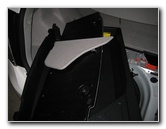 Spare Tire Cover Removed |
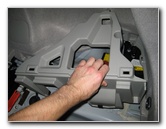 Battery Enclosure Removed |
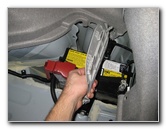 Remove "-" Cable Cover |
|
Follow the next few steps to avoid having your Prius dashboard light up like a Christmas tree with error codes such as "BRAKE", "ABS", "VSC" and the yellow or red exclamation point (brake system warning light). Failure to do so may immobilize your Prius until you clear the codes using the SST (Special Service Tool) # 09843-18040 (jumper wire). First power off the vehicle, pop the hood, and leave the driver door open. If you close the driver door, opening it again while the 12V battery is connected will cause the hydraulic braking system to pressurize. It's also a good idea to move the smart key for your Prius to another room so that the vehicle can not be turned on. Open the cargo tailgate door to access the 12V automotive battery located on the passenger side rear corner of the vehicle close to the right tail light assembly. |
||
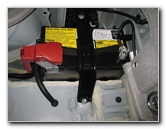 Prius 12V Battery |
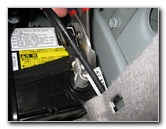 Loosen 10mm Negative Cable |
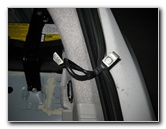 Disconnect "-" Battery Cable |
| Remove the folding
floor cargo cover, remove the cargo tray, lift off the battery top cover, remove the plastic cage that surrounds the battery
and finally remove the "-" battery cable cover at the right rear corner of
the trunk. Use a 10mm wrench or a socket with ratcheting wrench to remove the black "-" negative cable from the 12V battery. Rest the disconnected "-" battery cable on a non-metal surface or cover it with a non-conductive material to prevent it from accidentally touching the battery terminal. Do not close the tailgate door. The tailgate latch is electrical, not mechanical. So it can not be opened again with the battery disconnected. I'd recommend placing a towel over the latch so that the tailgate door can not be closed. |
||
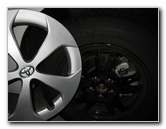 Remove Plastic Wheel Cover |
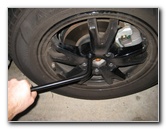 Loosen 5 Lug Nuts |
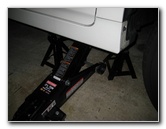 Raise Front of Vehicle |
| Chock the rear
wheels with blocks and engage the emergency / parking brake to prevent the
vehicle from moving. Move to the front wheels and pop off the plastic hub caps. Slightly Loosen the 5 lug nuts with the tire iron. Raise the front of the vehicle with the floor jack and securely support it with at least two jack stands. |
||
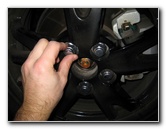 Spin Off Lug Nuts |
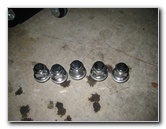 5 Lug Nuts Removed |
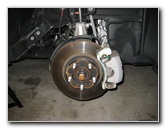 Front Brake Caliper & Rotor |
| Spin off the 5 lugs
nuts and set them aside in a safe place. Pull off the front wheel to reveal the front brake caliper, bracket, and rotor. |
||
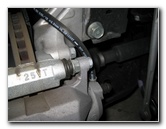 14mm Brake Caliper Bolt |
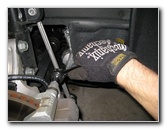 Loosen Upper Caliper Bolt |
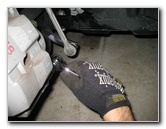 Loosen Lower Caliper Bolt |
| Look on the back
side of the brake caliper and locate the two 14mm bolts. Remove the upper and lower brake caliper bolts by turning them clockwise (as seen from outside the vehicle) with the 14mm socket and ratcheting wrench. Set the two caliper bolts aside in a safe place. |
||
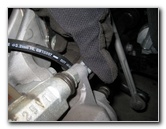 Remove Caliper Bolts |
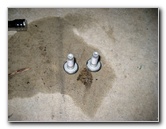 Two 14mm Caliper Bolts |
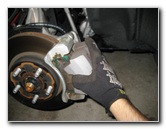 Pull Off Front Brake Caliper |
| Carefully pull the
brake caliper off the old pads and out of the bracket.
Securely rest the caliper on the suspension. |
||
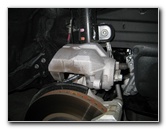 Rest Caliper On Suspension |
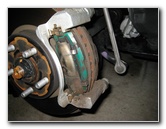 Brake Pads In Bracket |
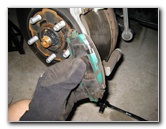 Pull Out Old Brake Pads |
| Pull the old brake
pads out of the bracket while making a mental note of how the wear or
"squeal" bars are situated. The wear bars on this 2012 Prius were located at the top of both the inner and outer pads. I recommend buying the Wagner ThermoQuiet QC1184A front brake pads since they have excellent reviews on Amazon. |
||
|
|
||
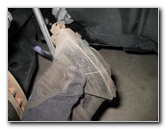 Wear Bars - Top of Pads |
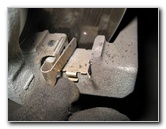 Metal Anti-Rattle Clips |
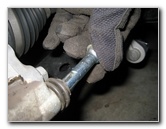 Pull Out Caliper Slider Pins |
| If your new set of
front brake pads came with new metal anti-rattle abutment clips, pull the old ones
out of the bracket and install the new clips. If your new pads did not come equipped with brake pad shims (the metal plate on the rear of the old pads), remove the old shims and install them on the new pads. In order for the brake caliper to work properly the caliper slider pins need to be well lubricated. Pull the upper and lower caliper pins out of their rubber dust boots and generously apply some disc brake caliper grease. Push the caliper slider pins back into their rubber dust boots until they snap into place. |
||
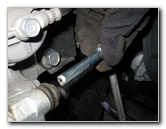 Lubricate Pins & Replace |
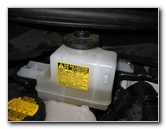 Brake Fluid Reservoir |
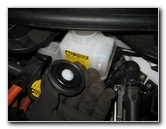 Twist Off Reservoir Cap |
| Thoroughly clean
off the brake rotor, caliper bracket, brake caliper assembly and the lug nut
studs with brake parts cleaner spray. Do not use compressed air or blow with
your mouth to clean off the brake parts since breathing in brake dust can be
harmful to your health. Brake dust can be carcinogenic (causes cancer) if
inhaled.
To remove the existing rotors and install new ones, just remove the two 17mm bolts on the rear of the caliper bracket that attach it to the steering knuckle. Then loosen the old rotor with a rubber mallet, pull it off, and slide the new one in its place. |
||
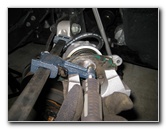 F Clamp - Compress Piston |
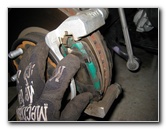 Install New Brake Pads |
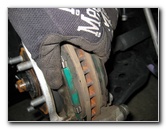 Press Pads Against Rotor |
| In order for the
brake caliper to fit over the thicker new brake pads, the caliper piston
will need to be compressed backwards by using a "C" or
"F" clamp. Attach the "C" or "F" clamp to the caliper piston using the back of an old brake pad to evenly distribute the force across the piston. Before you begin compressing the piston, move to the engine bay and twist off the brake fluid reservoir cap. Removing the cap will allow the brake fluid to more easily travel backwards through the brake lines. Repeatedly check the level in the brake fluid reservoir while slowly compressing the caliper piston to prevent it from overflowing which may damage any painted surfaces. Compress the piston until it is flush with its rubber dust boot. Promptly replace the brake fluid reservoir cap since brake fluid is hygroscopic (absorbs moisture). Install the new front brake pads into the caliper bracket with the wear bars at the top of both the inner and outer pads. If the new pads did not come with wear indicator bars, remove the wear bars from the old pads and install them at the top of each new pad. Push the brake pads flush against the rotor. |
||
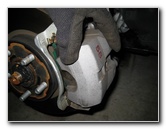 Lower Caliper Over Pads |
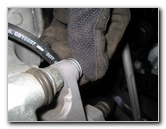 Insert Upper Caliper Bolt |
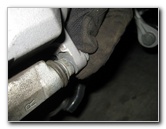 Thread In Lower 14mm Bolt |
| Carefully lower the
caliper over the new brake pads while lining up the bolt holes in the
caliper with the corresponding holes in the caliper bracket.
Insert the upper and lower caliper bolts by hand to prevent them from becoming cross threaded. |
||
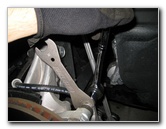 Attach 17mm Wrench |
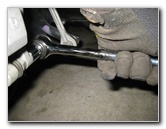 Tighten Both Caliper Bolts |
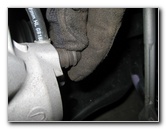 Brake Fluid Bleeder Valve |
| Tighten the two
caliper bolts with the 14mm socket and ratcheting wrench to just past hand
tight or about 25 ft lbs of torque. Double check that both the caliper bolts are tight before continuing on to the next steps. |
||
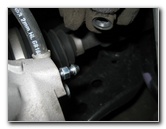 Bleed - Scan Tool Required |
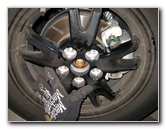 Replace Front Wheel |
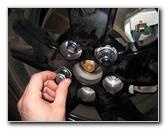 Spin On 5 Lug Nuts |
| (If you'd like to
properly bleed your brake fluid, it would be best to use a
Toyota Scan Tool connected
to the OBD II port in order to cycle the ABS solenoid valves.) Replace the front wheel and spin on the five lug nuts by hand to prevent them from becoming cross threaded. |
||
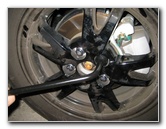 Slightly Tighten Lug Nuts |
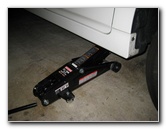 Lower Vehicle From Stands |
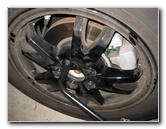 Torque Lug Nuts |
| Slightly tighten
the lug nuts with the tire iron. Lower the vehicle from the jack stands using the floor jack until the wheel holds some weight. Progressively tighten the lug nuts in a "criss cross" or star pattern to about 1/4 to 1/2 turn past hand tight. |
||
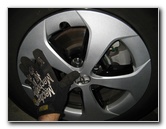 Replace Front Hub Cap |
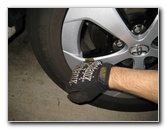 Secure Wheel Cover |
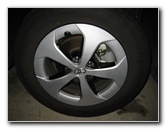 Front Brake Pads Replaced |
|
It would be best to use a
torque wrench or an
air gun with a torque stick to tighten the lug nuts to about 75-100 ft lbs
of torque.
Line up the plastic wheel cover with the valve stem going through the notch and firmly push it in to place. Tap the hub cap with your fist all around the edge to be sure it is seated well on the wheel. Sit in the driver's seat of the vehicle and pump the brake pedal a few times to restore brake line pressure. Check the DOT 3 brake fluid in the reservoir and verify that it is at the proper level. Replace the reservoir cap if you haven't already. (If you removed the two blue ABS relays, re-insert them into the engine bay fuse box.) Move to the cargo area and carefully reconnect the black "-" negative battery cable and tighten it using the 10mm wrench. Replace the plastic enclosure around the battery, the battery top cover, and the spare wheel cover. Power on the vehicle and check the dashboard for any error warning lights. If there are none, take the car for a short and cautious test drive. You may need to reset the clock, radio presets and the power window auto up/down and jam protection features. To reset the auto window feature, push down the switch to lower the window down halfway. Then pull up the switch until the window reaches the top and hold the switch for a few seconds. Check that the auto window feature now works properly. If not, try putting the window all the way down, then all the way up while continuing to hold the switch up for 10 seconds. If you do see any warning lights, first try powering off the vehicle, pumping the brake pedal a few times, and then powering the vehicle back on.
If you still see any error warning lights such as ABS, VSC, BRAKE and/or a yellow or red exclamation point, you will need to clear the codes using the SST (Special Service Tool) # 09843-18040 which is just a fancy jumper wire. Some people have reported success using a paper clip bent into a "U" shape. The procedure is as follows: with the car off, connect pin # 4 (CG - Chassis Ground) and pin # 13 (TC) on the OBD2 ("DLC" Data Link Connector) port located under the steering column by the driver's left knee. Warning - Shorting together the wrong pins can cause damage to your vehicle! (The pins are numbered from top to bottom and left to right so the # 1 pin is the first one at the top left of the connector.) Double check that you correctly have pins # 4 (4th from the left on the top row) and # 13 (5th from left on the bottom row) connected. This applies to most trapezoid shaped Toyota OBD II ports that are installed with the longer end of the at top and the shorter side at the bottom. If your trapezoid shaped Toyota OBD II (DLC3) port is installed with the shorter side at the top and the longer side at the bottom, refer to this OBD II Pin Diagram image. The same as above applies: connect pin # 13 (fourth in on top row) and pin # 4 (fifth in on bottom row). Turn the power switch to "On" (ready) so that the dashboard lights up but the engine does not run. Tap the brake pedal rapidly 8 or more times in 5 seconds. Remove the jumper wire and power off the vehicle. Power on the vehicle and check the system display on the dashboard. It should now appear to be normal. Take the car for a short and cautious test drive. To break in your new front brake pads, just drive normally for the first few hundred miles while trying to avoid any hard or "panic" stops which may glaze over the new brake pads and cause them to be noisy and not perform as well. It's also a good idea to regularly check your driveway for drops of brake fluid which may indicate a leak, check the brake fluid level in the reservoir, and also check that the lug nuts are still tight. For more,
check out my other
Toyota Prius DIY Repair & Maintenance Guides. |
||
| If you found this guide to be helpful,
please consider making a small donation by clicking on the PayPal.com
"Donate" button located to the right of this paragraph. Thank you!
(Note: I am not a registered charity. Donations are not tax deductible.) |

